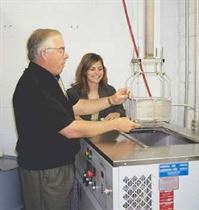What's the Difference Between an Aqueous Ultrasonic Cleaner and a Vapor Degreaser?
Most ultrasonic degreasers are single-tank systems containing a slow-drying nonflammable liquid, such as water, enhanced with a soap or saponifier. These machines are simple, inexpensive, and easy to use. But they do not deliver the highest quality cleaning because they have no way to rinse the contamination from the parts being cleaned.
In contrast, vapor degreasing uses at least two tanks (also called sumps) inside the cleaning system. The tanks have different names: one is the “boil sump” where the cleaning happens, and the other is the “rinse sump.” Those tanks are filled with a specialized non-aqueous, nonflammable cleaning fluid, never water, optimized for the type of contamination being removed. There are many choices for these cleaning fluids, but most of these cleaning fluids have a couple of traits in common: they boil at relatively low temperatures (typically 40˚C instead of the 100˚C of water) and they have the right chemical characteristics (surface tension, density, etc.) to deliver fast and easy critical cleaning.
Now there are many nuances to this discussion, more than we can put into this FAQ. But basically the differences between aqueous ultrasonic cleaning and vapor degreasing are night and day. Aqueous ultrasonic cleaning is cheap, but also slower, and more limited. Vapor degreasing is fast, safe, economical, consistent, and delivers absolutely perfectly and consistently clean parts, every single time.
How clean do your parts need to be? If you need perfect cleaning, quickly, easily, gently, safely, inexpensively, then you need a vapor degreaser.

